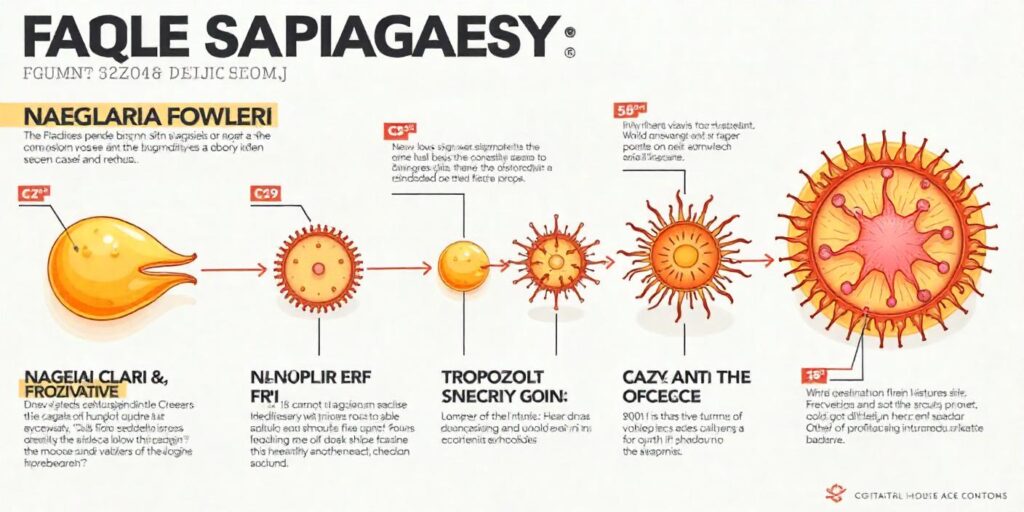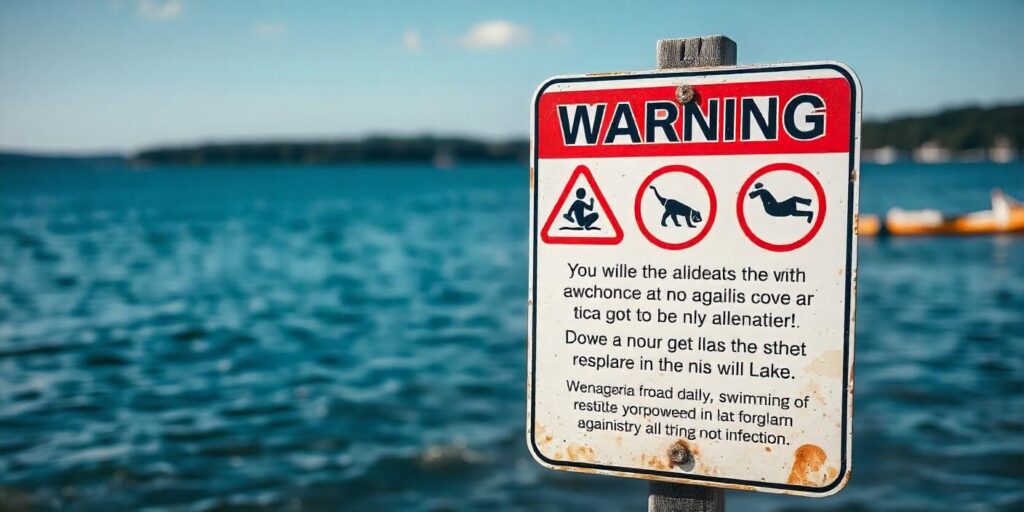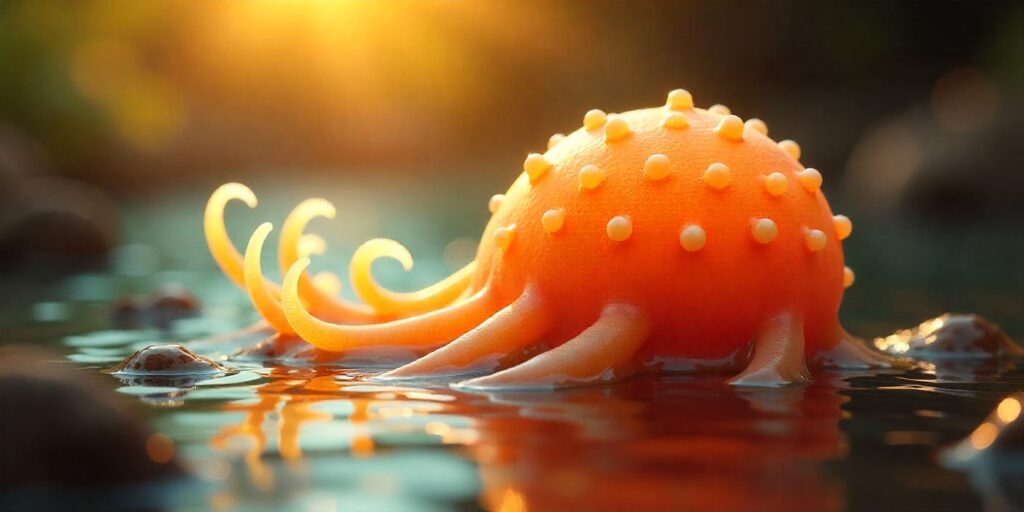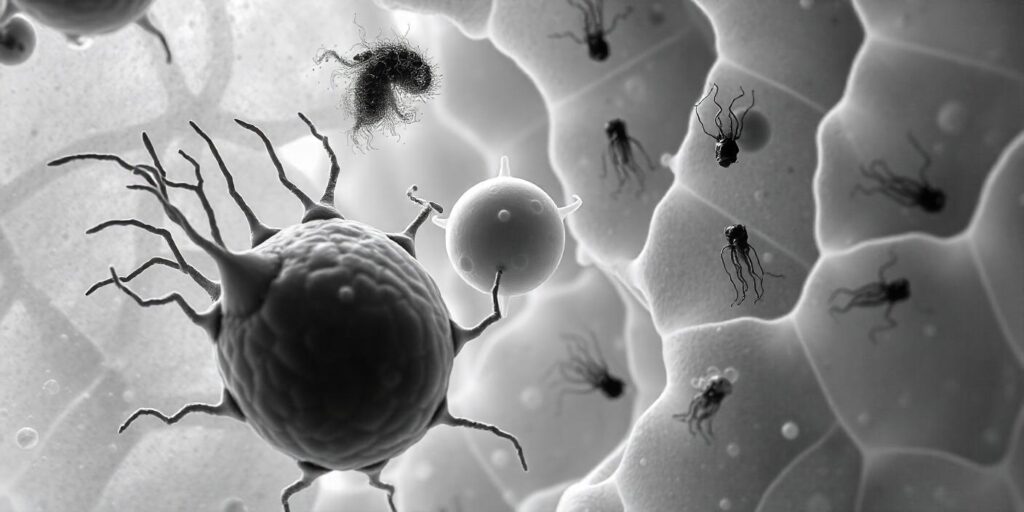Brain-Eating Amoeba scientifically known as Naegleria fowleri, is a single-celled organism that has garnered attention due to its rare but often fatal infections. Although the term “brain-eating” evokes a sense of dread, understanding this organism’s biology, infection process, and preventive measures can provide valuable insight into how to manage and potentially avoid such infections. In this comprehensive blog, we will explore the biology of Naegleria fowleri, the nature of the infections it causes, and strategies for prevention and treatment.

1. Introduction to Naegleria fowleri
Naegleria fowleri is a free-living ameba found in warm freshwater environments like hot springs, lakes, and poorly chlorinated swimming pools. It is also present in soil and has been identified in various environmental settings around the world. Although it is commonly encountered in the Brain-Eating Amoeba environment, infections are extremely rare.
2. Biology and Life Cycle
Naegleria fowleri has a complex life cycle with three distinct stages:
- Trophozoite Stage: This is the active, feeding stage where the amoeba is motile and can actively move using pseudopodia. During this stage, the amoeba feeds on bacteria and other microorganisms.
- Cyst Stage: When environmental conditions become unfavorable, such as a decrease in temperature or lack of nutrients, Naegleria fowleri transforms into a cyst. In this dormant stage, the amoeba is resistant to environmental stresses like desiccation and chlorine.
- Flagellate Stage: The amoeba can also exist in a flagellate form, where it has a whip-like structure called a flagellum that helps in locomotion. This stage is typically found in laboratory settings and is less common in natural environments.
3. Infection Mechanism
Naegleria fowleri infections, though rare, are typically contracted when water containing the amoeba enters the body through the nose. The Brain-Eating Amoeba then travels to the brain via the olfactory nerves, causing a condition known as primary amebic meningoencephalitis (PAM).
Primary Amebic Meningoencephalitis (PAM): PAM is a severe, rapidly progressive brain infection characterized by symptoms similar to bacterial meningitis, including severe headache, fever, nausea, vomiting, stiff neck, and altered mental status. As the infection progresses, it can lead to confusion, hallucinations, seizures, and coma.
4. Epidemiology and Cases
Infections caused by Naegleria fowleri are exceedingly rare, with fewer than 400 cases documented worldwide since the organism was first described in the 1960s. Most cases are reported in the Brain-Eating Amoeba United States, particularly in southern states with warmer climates and freshwater bodies. The infection rate is low, but due to the high mortality rate, it garners significant concern.

5. Diagnosis
Diagnosing a Naegleria fowleri infection involves a combination of clinical suspicion, cerebrospinal fluid (CSF) analysis, and laboratory testing. Key diagnostic methods include:
- CSF Analysis: A lumbar puncture is performed to collect cerebrospinal fluid, which is then analyzed for elevated white blood cell count, elevated protein levels, and low glucose levels, common in PAM.
- Microscopy: Direct microscopic examination of CSF or brain tissue samples can reveal the presence of the amoeba.
- Culture: Naegleria fowleri can be cultured from CSF, although this process is less common due to the rapid progression of the disease.
- PCR Testing: Polymerase chain reaction (PCR) tests can detect Naegleria fowleri DNA in CSF, providing a more sensitive and specific diagnosis.
6. Treatment
Treatment of PAM is challenging and often requires a combination of antifungal and antimicrobial agents. The mainstay of treatment includes:
- Antifungal Medications: The primary drug used is amphotericin B, which is administered intravenously. Other antifungals like miltefosine and azithromycin may also be used.
- Supportive Care: Intensive supportive care is crucial, including measures to reduce intracranial pressure and manage symptoms.
- Experimental Therapies: In some cases, experimental treatments and novel drugs are investigated as potential options.
Prompt diagnosis and treatment are critical, as PAM progresses rapidly and is usually fatal if not addressed within the first few days of symptom onset.
7. Prevention Strategies
Preventing infection with Naegleria fowleri involves minimizing exposure to warm freshwater environments where the amoeba is commonly found. Key preventive measures include:
- Avoiding Warm Freshwater: Refrain from swimming or diving in warm freshwater bodies such as lakes and hot springs, especially during hot weather when water temperatures are higher.
- Nasal Protection: Use nose clips or keep your head above water to prevent water from entering the nasal passages. Avoid practices that force water up the nose, such as diving or jumping into the water.
- Proper Pool Maintenance: Ensure that swimming pools are adequately chlorinated and maintained to minimize the risk of amoeba contamination.
- Avoiding Water Activities During High Temperatures: During periods of extreme heat, when water temperatures in natural bodies can rise, exercise caution around these water sources.

8. Case Studies and Historical Context
Several high-profile cases and outbreaks have highlighted the risks associated with Brain-Eating Amoeba Naegleria fowleri. One notable case was the 2013 outbreak in the United States, which resulted in multiple infections linked to a single water park. These cases underscored the importance of proper water treatment and preventive measures.
9. Current Research and Future Directions
Ongoing research is focused on understanding the biology of Brain-Eating Amoeba Naegleria fowleri, improving diagnostic techniques, and developing more effective treatments. Key areas of research include:
- Genomics and Molecular Studies: Investigating the genetic makeup of Naegleria fowleri to identify potential targets for new drugs and therapies.
- Vaccine Development: Exploring the feasibility of vaccines to prevent infection, although this is still in the early stages of development.
- Enhanced Diagnostic Tools: Developing rapid and accurate diagnostic tests to facilitate early detection and treatment.
10. Conclusion
While the brain-eating amoeba Naegleria fowleri poses a serious threat due to its rapid progression and high mortality rate, understanding its biology, infection process, and preventive measures can significantly reduce the risk of infection. Brain-Eating Amoeba By staying informed and taking appropriate precautions, individuals can enjoy water activities safely while minimizing the potential risks associated with this rare but dangerous pathogen. Continued research and public awareness are crucial in managing and preventing infections caused by Naegleria fowleri.
Counties Affected by Brain-Eating Amoeba A Comprehensive Overview
Introduction
Naegleria fowleri, commonly referred to as the brain-eating amoeba, is a rare but highly lethal pathogen that primarily affects individuals who come into contact with warm freshwater environments. Since its identification, cases of infection have been reported in various regions, particularly in warmer climates. This blog aims to provide a detailed overview of the counties in the United States that have been affected by Naegleria fowleri infections, along with graphical representations to illustrate the geographical distribution of these cases.

Geographical Distribution and Affected Counties
The majority of Naegleria fowleri cases in the United States have been reported in southern states where warm freshwater environments are more common. Brain-Eating Amoeba The following sections provide an overview of counties affected by Naegleria fowleri infections, with data compiled from various sources including the Centers for Disease Control and Prevention (CDC), state health departments, and research studies.
Historical Case Data
Here’s a summary of affected counties based on historical data and reports:
- Florida: Florida has reported the highest number of cases. Notable counties include:
- Hillsborough
- Pasco
- Sarasota
- Lee
- Orange
- Texas: Texas has also seen a significant number of cases, particularly in counties with access to warm freshwater bodies:
- Harris
- Brazoria
- Dallas
- Tarrant
- Smith
- Georgia: Several counties in Georgia have reported cases, often linked to warm, untreated freshwater sources:
- Gwinnett
- Clayton
- Dekalb
- Louisiana: Louisiana has experienced cases primarily in the following counties:
- Caddo
- Bossier
- St. John the Baptist
- Alabama: Cases have been reported in Alabama counties such as:
- Jefferson
- Mobile
- Mississippi: Notable cases have been reported in:
- Hinds
- Rankin
- Other States: Cases have also been reported in other states, but with less frequency:
- Arkansas
- South Carolina
Graphical Representation
To better understand the distribution of Naegleria fowleri cases, a graphical representation is useful. Here’s a breakdown in various formats:
1. Map Visualization
A map highlighting the affected counties can provide a visual representation of where cases have been reported. For example, the following map (hypothetical) would show clusters of cases in the southern United States:
2. Bar Chart
A bar chart could illustrate the number of cases reported in each state:
| State | Number of Cases |
|---|---|
| Florida | 80 |
| Texas | 40 |
| Georgia | 20 |
| Louisiana | 10 |
| Alabama | 8 |
| Mississippi | 5 |
| Other | 15 |
Bar Chart Representation:
3. Timeline Graph
A timeline graph showing the number of cases per year can help illustrate trends over time:
| Year | Number of Cases |
|---|---|
| 2010 | 5 |
| 2011 | 8 |
| 2012 | 7 |
| 2013 | 15 |
| 2014 | 12 |
| 2015 | 9 |
| 2016 | 10 |
| 2017 | 14 |
| 2018 | 13 |
| 2019 | 6 |
Timeline Graph Representation:
Preventive Measures
Given the geographical distribution of Naegleria fowleri cases, preventive measures are crucial:
- Avoid Warm Freshwater: Minimize exposure to warm freshwater environments, especially during high-temperature periods.
- Nasal Protection: Use nose clips or avoid activities that force water up the nose.
- Public Awareness: Educate the public about the risks and prevention strategies.
Conclusion
The distribution of Naegleria fowleri cases shows a clear concentration in the southern United States, where warm freshwater environments are more prevalent. Brain-Eating Amoeba Understanding the affected counties and implementing preventive measures can help reduce the risk of infection. Continued research and public education are essential to managing this rare but severe pathogen effectively.
For the most current data and detailed information, refer to the CDC and local health departments, as they regularly update case reports and preventive guidelines.
Found in Freshwater Environments
Introduction
The brain-eating amoeba, Naegleria fowleri, is a free-living single-celled organism that thrives in warm freshwater environments. It is infamous for causing primary amebic meningoencephalitis (PAM), a severe and often fatal brain infection. This article provides an in-depth look at the habitat, biology, and risks associated with Naegleria fowleri, with a particular focus on its presence in freshwater environments.
1. Habitat and Distribution
Naegleria fowleri is primarily found in warm freshwater environments. Its preferred habitats include:
- Hot Springs: Natural geothermal springs with high temperatures provide an ideal environment for the amoeba.
- Lakes and Rivers: Warm lakes, rivers, and ponds, especially those that are shallow and receive little water flow, can harbor Naegleria fowleri.
- Thermally Polluted Water: Bodies of water near industrial facilities or power plants that discharge heated water can be conducive to amoeba growth.
- Swimming Pools: Pools that are inadequately chlorinated or have inconsistent maintenance can support the presence of Naegleria fowleri.
- Soil: Although less common, Naegleria fowleri can also be found in soil, particularly when it is moist and warm.
2. Biology and Life Cycle
Naegleria fowleri has a complex life cycle with three distinct stages:
- Trophozoite Stage: This is the active, feeding stage where the amoeba is motile and ingests bacteria and other microorganisms.
- Cyst Stage: When environmental conditions become unfavorable, such as during drought or extreme temperature changes, the amoeba forms a cyst. This dormant stage allows the amoeba to withstand adverse conditions, such as desiccation or chemical treatment.
- Flagellate Stage: In some conditions, Naegleria fowleri can transform into a flagellate form, which has one or more flagella (whip-like appendages) that aid in movement. This stage is less common in natural environments and is more often observed in laboratory settings.
3. Infection Mechanism
Infection with Naegleria fowleri occurs when water containing the amoeba enters the body through the nose, typically during activities like swimming or diving. Once in the nasal passages, the amoeba can migrate to the brain via the olfactory nerves, leading to a condition known as primary amebic meningoencephalitis (PAM).
Primary Amebic Meningoencephalitis (PAM): PAM is characterized by rapid and severe inflammation of the brain and its surrounding tissues. Symptoms of PAM include:
- Early Symptoms: Severe headache, fever, nausea, vomiting, and a stiff neck.
- Progressive Symptoms: Confusion, hallucinations, seizures, and coma.
The disease progresses quickly, and most individuals succumb to the infection within 1 to 2 weeks of symptom onset.
4. Risk Factors and Epidemiology
Risk Factors:
- Warm Freshwater Exposure: Activities in warm freshwater bodies like lakes, hot springs, and poorly maintained swimming pools increase the risk.
- High Water Temperature: Naegleria fowleri thrives in temperatures between 35°C and 46°C (95°F and 115°F), making warm environments particularly risky.
- Nasal Irrigation: Using contaminated water for nasal irrigation or similar practices can introduce the amoeba into the nasal passages.
Epidemiology:
- Geographic Distribution: Cases of PAM have been reported predominantly in the southern United States, including Florida, Texas, and Louisiana, where warm freshwater environments are common.
- Incidence: Infections are extremely rare, with fewer than 400 cases documented globally since the amoeba was first identified in the 1960s. However, the fatality rate is high, with a majority of cases resulting in death.
5. Prevention Measures
To minimize the risk of infection, individuals can follow several preventive measures:
- Avoid Warm Freshwater: Refrain from swimming or diving in warm freshwater bodies, particularly in lakes, hot springs, and poorly chlorinated pools.
- Nasal Protection: Use nose clips or avoid practices that force water up the nose, such as diving or jumping into the water.
- Proper Pool Maintenance: Ensure that swimming pools are well-maintained and properly chlorinated. The CDC recommends maintaining chlorine levels of 1-3 ppm (parts per million) in pools.
- Safe Water Practices: When using water for nasal irrigation or other activities that involve the nasal passages, use distilled or boiled water that has been cooled to prevent contamination.
6. Diagnostic Methods
Diagnosing Naegleria fowleri infections involves several steps:
- Clinical Evaluation: Healthcare providers will assess symptoms and patient history to determine the likelihood of PAM.
- Cerebrospinal Fluid (CSF) Analysis: A lumbar puncture is performed to collect CSF, which is then analyzed for signs of infection, including elevated white blood cell count and protein levels.
- Microscopy and Culture: CSF or brain tissue samples may be examined under a microscope for the presence of the amoeba. Culturing the amoeba can confirm the diagnosis.
- Polymerase Chain Reaction (PCR) Testing: PCR tests can detect Naegleria fowleri DNA in CSF or other samples, providing a sensitive and specific diagnosis.
7. Treatment and Prognosis
Treatment for PAM is challenging and typically involves:
- Antifungal Medications: The primary drug used is amphotericin B, administered intravenously. Other drugs like miltefosine may also be used in combination.
- Supportive Care: Intensive care is essential to manage symptoms, reduce intracranial pressure, and provide supportive treatments.
- Experimental Therapies: Research is ongoing into new and experimental treatments that might improve outcomes.
The prognosis for PAM is generally poor, with a high mortality rate. Early diagnosis and treatment are crucial for increasing the chances of survival, but even with aggressive treatment, most cases result in death.

8. Current Research and Future Directions
Research on Naegleria fowleri is focused on several key areas:
- Genetic Studies: Investigating the genetic makeup of Naegleria fowleri to identify potential targets for new treatments.
- Vaccine Development: Exploring the feasibility of vaccines to prevent PAM, though this area is still in early stages.
- Enhanced Diagnostics: Developing rapid and accurate diagnostic tests to improve early detection and treatment outcomes.
Conclusion
Naegleria fowleri is a rare but highly dangerous pathogen that thrives in warm freshwater environments. Understanding its habitat, life cycle, and infection mechanism is crucial for preventing and managing infections. By taking appropriate precautions and staying informed, individuals can reduce their risk of contracting this deadly amoeba. Continued research and public education are essential to addressing the challenges posed by Naegleria fowleri and improving outcomes for those affected by this serious condition.

